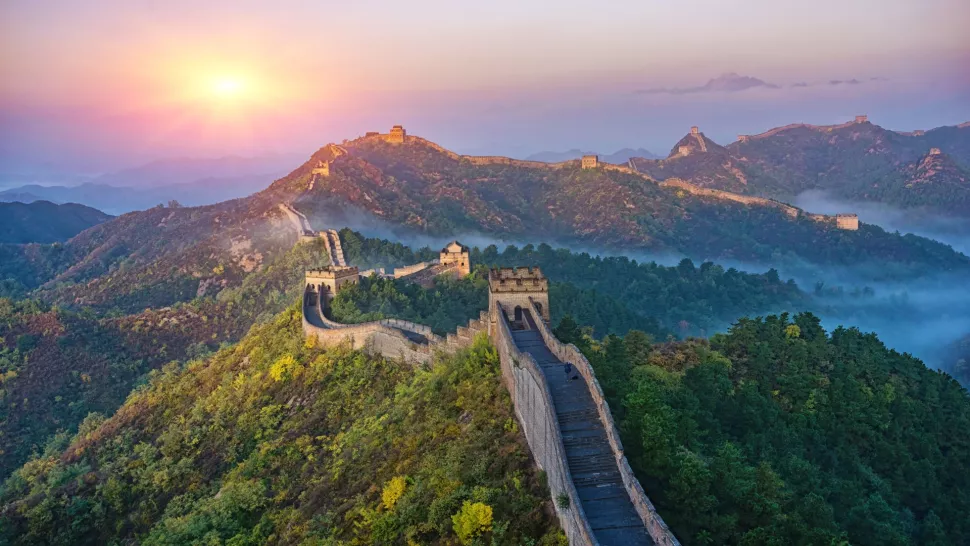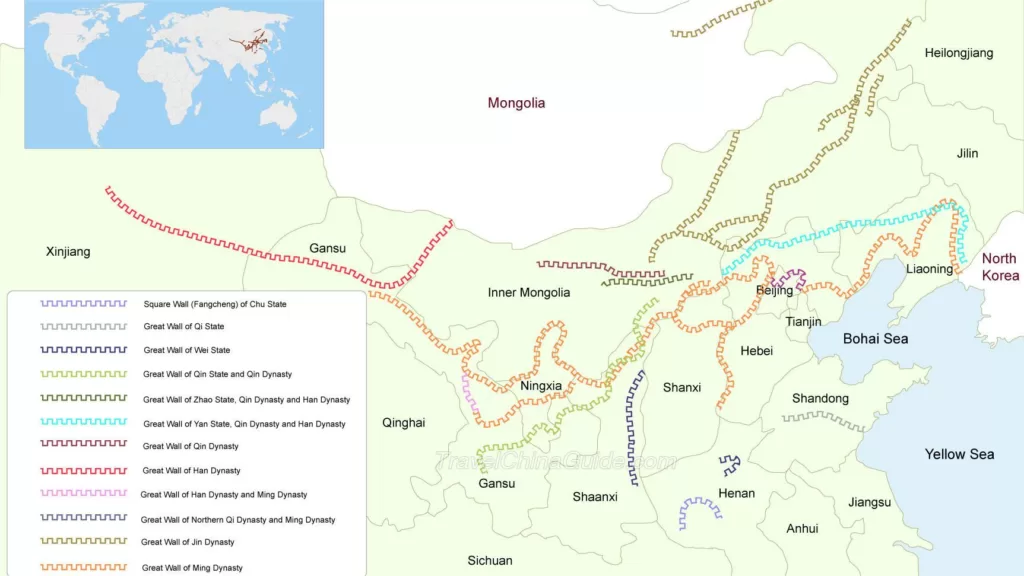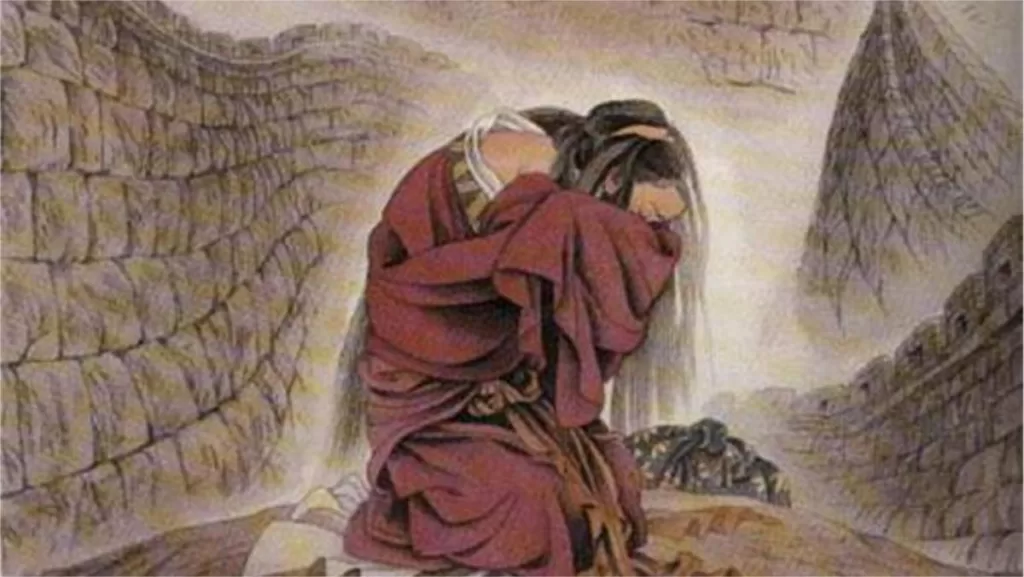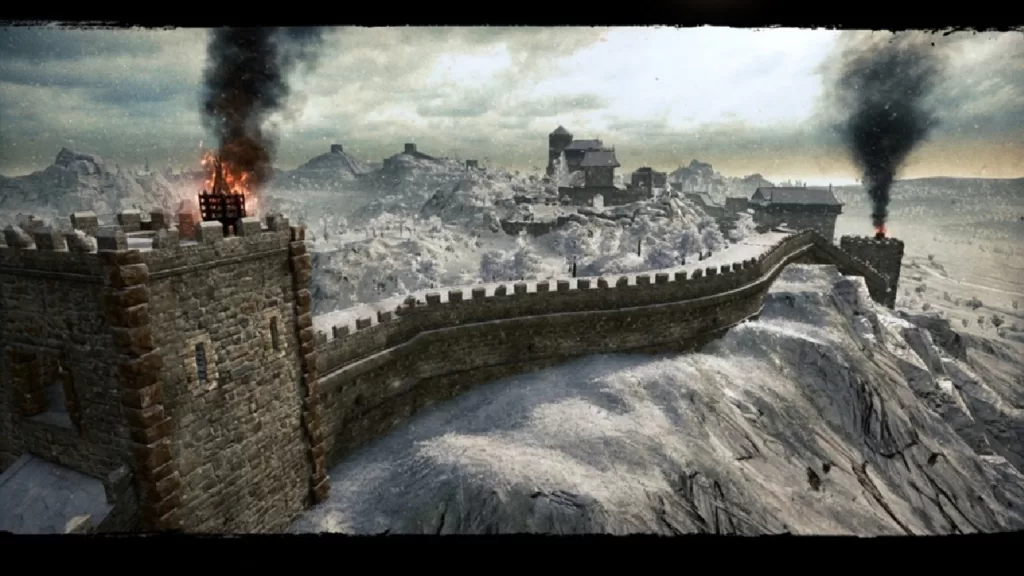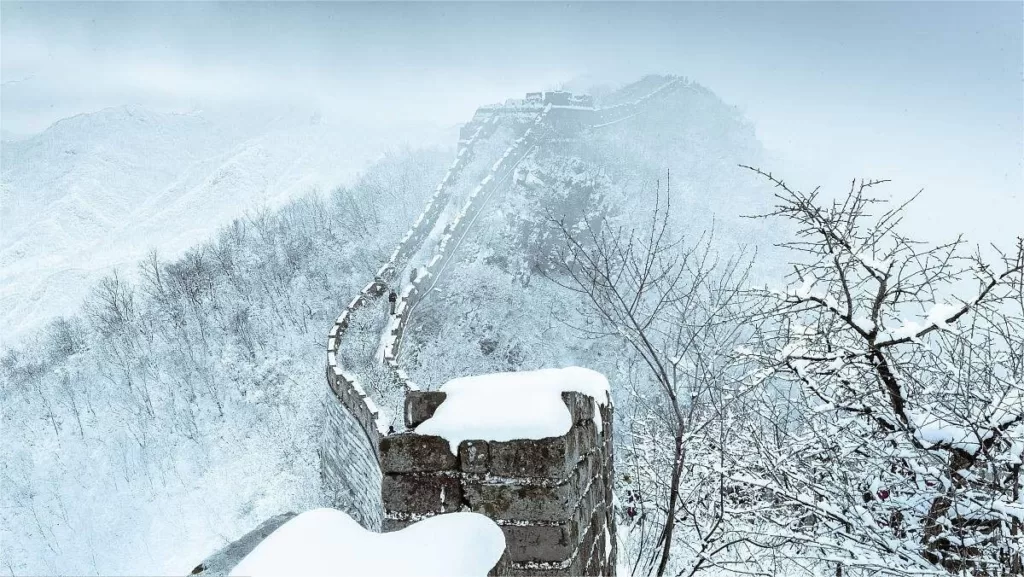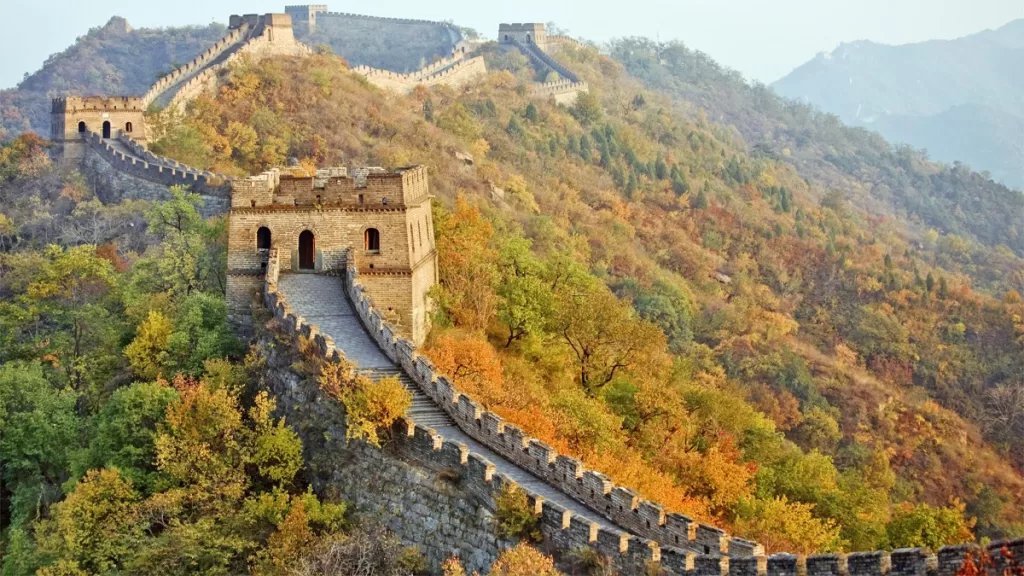Historical records show that over 2000 years ago, Chinese people had constructed walls to guard them against the invasion of the nomads from the north. And when it came to the Ming dynasty (1368 A.D. – 1644 A.D.), the government poured enormous effort, money, and labors into this project. The regime has perished, but the buildings it constructed remain and become what we know as the Great Wall, which stretches more than 20,000 kilometers.
Although you may find the relics of the Great Wall in almost every northern province in China, those in Badaling, Beijing are one of the best preserved. After renovation, it opened to the public in 1953 and has received billions of tourists in the past decades. It is the icon of China and an attraction to which you should seize every opportunity to visit.
Table of Contents
- Basic information
- Location and Transportation
- Highlights of Badaling Great Wall
- Recommended Routes
- Vlog about Badaling Great Wall
- Best Time to Visit Badaling
- Phtography Tips and Spots
- Food Options at Badaling Great Wall
- Useful Tips Summarized from Reviews
- Interesting Facts
- Other Sections of Great Wall in Beijing
- Attractions near Badaling Great Wall
Basic information
| Website | http://www.badaling.cn |
| Estimated length of tour | about 3 hours |
| Opening hours | 06.30 – 16.30 throughout the year; Last entry: 16.00 |
| Ticket price | Adult: 40 RMB (approx. 5.6 dollars from April 1st to October 31st) 35 RMB (approx. 5 dollars from November 1st to March 31st) Children under 1.2 meters: free of charge |
Location and Transportation
The Beijing Great Wall is located in the suburb, about 70 kilometers from the city center to the northwest.
Bus (cheap, but time-consuming): Take No.919 or 877 at Deshengmen station (basically the city center of Beijing, very easy to reach). The bus departs every 5 minutes and costs only 12 RMB (If you have a public transport card, it reduces to 6 RMB). But it is a little slow, taking about 1.5 hours to reach Badaling Great Wall.
Trains (highly-recommended): There are two railways to the Great Wall. One is from the Beijing North Railway Station (25 RMB), and the other is from Qinghe Station (20 RMB). You can book the ticket on the spot or online (www.12306.cn). The journey lasts for about half an hour. But there is only one departure a day, the one from Beijing North Railway Station at 08.43 a.m. and from Qinghe Station at 10.58. You need to arrive at the station at least 15 minutes in advance.
Private Transfer: You can also use the private transfer service to get Badaling, which will pick you up from your hotel at your prefferred time.
Highlights of Badaling Great Wall
Enermy Towers (敌楼)
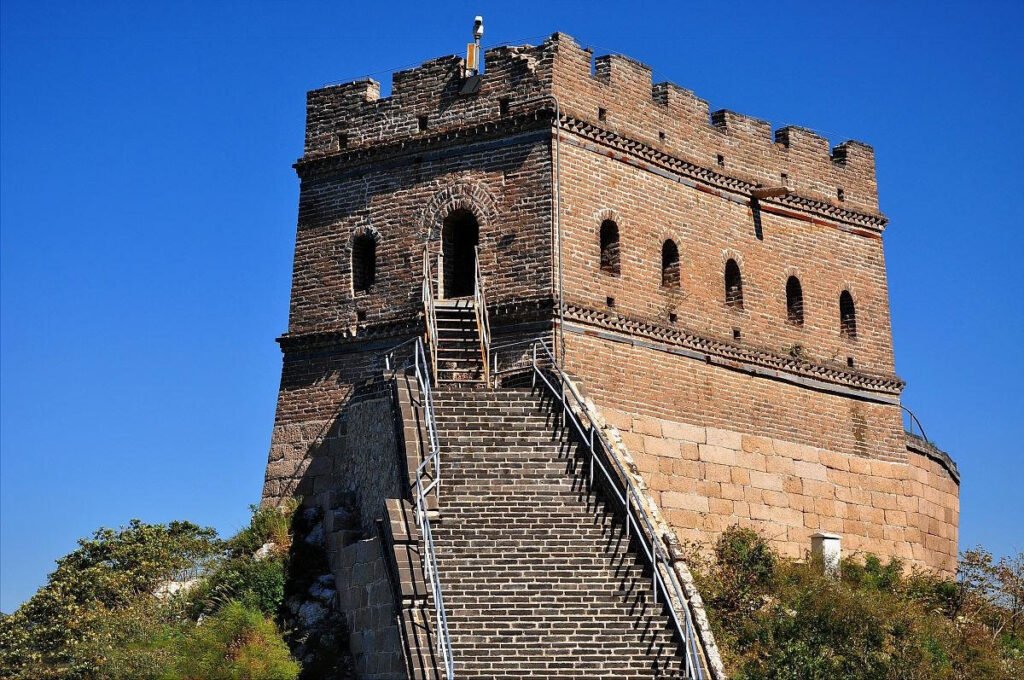
Badaling Great Wall boasts a total of 43 enemy towers, each uniquely constructed yet sharing common architectural features. These towers served multiple purposes, including patrolling, signaling, and housing soldiers and supplies. The towers are strategically spaced based on the terrain and mountain slopes, and they are built entirely from bricks and stones. Each tower typically has two levels, with the upper level featuring parapets and shooting holes, while the lower level provides accommodation and storage.

South and North Fourth Towers
Located on the southern and northern peaks of Guan City, these four enemy towers on each peak were the first sections of the wall to be opened for tourism. The elevation difference between the peaks and the steep slopes make these towers particularly impressive. From Guan City to the South Fourth Tower, the wall stretches 685.8 meters and ascends 127 meters, with an average incline of 1 meter for every 6 meters of distance. Between the third and fourth towers on the south, the wall meanders for about 500 meters, with slopes as steep as 70 degrees.
The journey from Guan City to the North Fourth Tower covers 767.5 meters with an ascent of 155 meters. Though longer than the southern route, it is less steep. The path to the North Fourth Tower includes a saddle-shaped section with over 100 steps. These eight towers and the connecting walls were restored in the 1950s. Originally, the northern four towers were two-story structures, but only three were fully restored, with the third tower missing its upper level. Similarly, the upper levels of the first and second towers on the southern peak were not restored.

North Fifth Tower
Known for having the most arched vaults, the North Fifth Tower measures 9.25 meters in length and 9.34 meters in width, with two levels. The first floor features numerous arched vaults, with four rows of brick piers on each side, supporting over 30 arched vaults that elevate the second floor.
North Sixth Tower
The largest of all enemy towers at Badaling, the North Sixth Tower spans 12.6 meters in length and 8.5 meters in width, with a ground floor area of about 100 square meters. It has seven rows of brick piers on the long side and four rows on the short side, creating a square corridor with a rectangular courtyard in the middle. Visitors can climb to the top via a ladder from the courtyard.
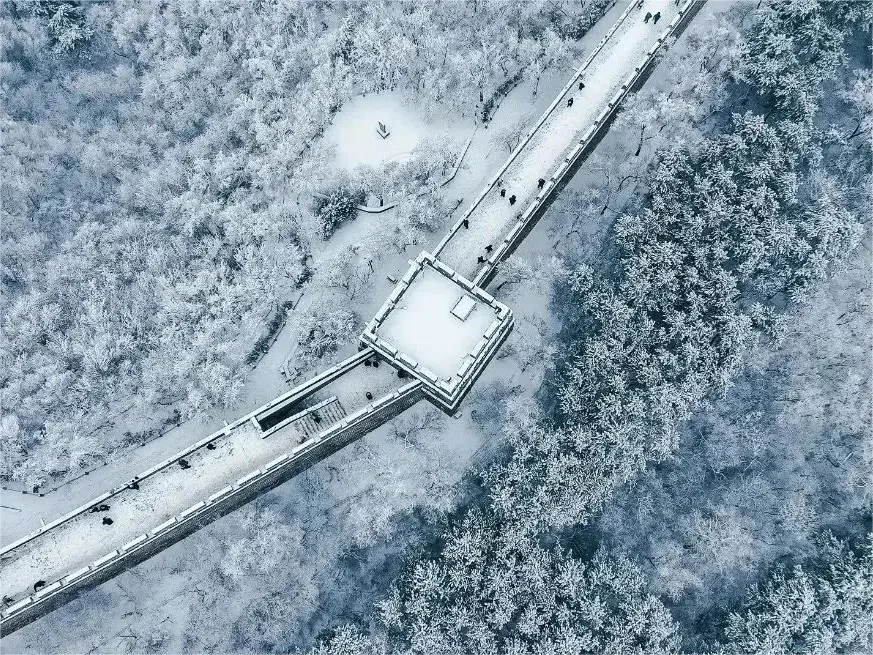
North Eighth Tower
At an elevation of 888 meters, the North Eighth Tower is the highest point on the Badaling Great Wall, offering the best panoramic views. Known as the “Sun Viewing Platform,” this two-story tower has six arrow windows on the enemy-facing side, the most of any tower. The distance from Guan City to the North Eighth Tower is over 1500 meters, with a relative height of 228 meters.
Towers with Dormitories
Among the newly restored towers, two have dormitory rooms: the North Tenth Tower and the South Sixth Tower. These dormitories are small rooms on the second floor with gabled roofs, red columns, and intricately carved windows.
Beacon Towers (烽火台)
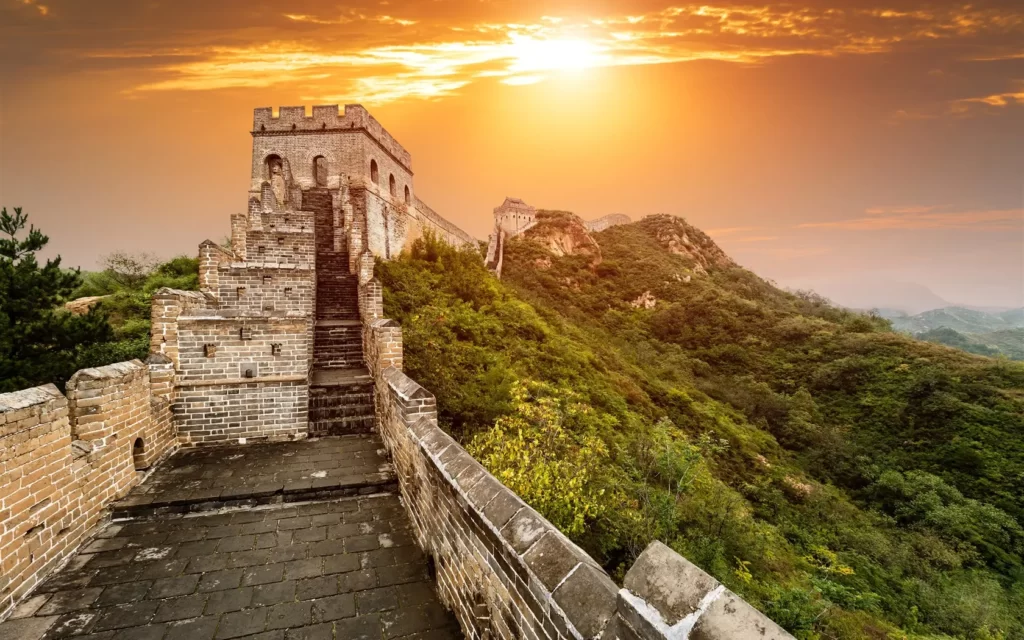
The Badaling Great Wall features distinctive beacon towers, known as “Dun Tai” (墩台), located on the eastern and western hills. Each beacon tower stands five zhang (about 16.5 meters) high, surrounded by a small fortress. The fortress is 1.5 zhang (about 5 meters) tall and equipped with hanging wooden watchtowers, moats with drawbridges, and trap pits. The gates have water tanks to store ice in winter and water in summer, and rope ladders are used instead of stairs for access. Each tower is armed with two cannons and guarded by ten soldiers from nearby forts, creating a deep defense network. In 1466, the Ming Dynasty established a signaling system: one beacon and one cannon for 100 enemies, two for 500, three for 1,000, four for 5,000, and five for 10,000 or more. This system ensured timely communication and defense against invasions.
Guan City (关城)

Guan City is a crucial part of the Badaling Great Wall, featuring the East and West Gates. The East Gate once had a temple called Wangjing Temple with a large stone-carved statue of the Great Compassion Buddha, while the West Gate had a memorial archway inscribed with “Driving Away the Barbarians for Thousands of Miles”. Both the temple and archway were dismantled during the construction of Guan City in 1505 by Wu Yiguan, a high-ranking official of the Dali Temple.
The walls of Guan City are robust, with the lower section made of over ten layers of granite slabs and the upper section built with large bricks. The walls are approximately 20 meters wide, 17 meters thick, and 7.8 meters high. At the top, there is a rectangular platform, 19.8 meters long and 14.15 meters wide, with an area of 280.17 square meters. The platform is surrounded by parapets.
On either side of the platform, about 30-40 meters away, stand enemy towers connected to the main wall, forming a defensive angle. The western wall connects to the southern and northern walls, which are built along the mountain ridges, creating a U-shape and meeting at the East Gate. The walls are 3.3 meters thick, 7.6 meters high, and have a circumference of 2070 meters. The distance between the East and West Gates is 63.9 meters, enclosing an area of approximately 5000 square meters.
The East Gate, established in 1539 during the Jiajing period, bears the inscription “Juyong Outpost” (居庸外镇), while the West Gate, established in 1582 during the Wanli period, is inscribed with “The Key to the North Gate” (北门锁钥). Both gates are well-preserved.
Ancient Cannons (古炮)

Five iron cannons are displayed near the entrance of Guan City, along the horse path, showcasing the advanced weaponry of the time. The largest cannon, measuring 2.85 meters in length with a caliber of 105 millimeters, has a range of over a kilometer. This cannon, inscribed with “Bestowed by the Emperor as the Mighty General” (敕赐神威大将军), was manufactured in 1638 during the reign of Emperor Chongzhen of the Ming Dynasty. It was transported from the Zhangbao area, over ten kilometers east of Badaling, in 1958.
Additionally, there are four smaller “Ox-Leg” cannons, unearthed during the restoration of the Great Wall in 1957. Alongside these cannons, hundreds of cannonballs, all dating back to the Ming Dynasty, were discovered. These artifacts provide a vivid representation of the military history and defensive capabilities of the Great Wall during the Ming era.
Recommended Routes

There are two routes to tour the Great Wall. One extends to the north, and the other to the south. There are more attractions on the northern route, and when you reach the end, you can directly take the cable to return to the entrance. But it is often crowded with people.
The southern route is a little shorter and much quieter, with the same astonishing views. The only problem is that when you reach the end, you have to take the original way back, which is disappointing, especially if you have been exhausted.
Of course, if you are fit enough, you can take both routes to enjoy the view fully.
Vlog about Badaling Great Wall
Best Time to Visit Badaling
Spring (March – May)
Spring is arguably one of the most beautiful times to visit Badaling Great Wall. As nature awakens from its winter slumber, the area is adorned with blooming flowers and budding trees, creating a vibrant and lively atmosphere. The landscape transforms into a colorful tapestry, with blossoms such as peach flowers, cherry blossoms, and azaleas adding splashes of pink, red, and white to the scenery.
Summer (June – August)
Summer at Badaling Great Wall is characterized by warmer weather and lush greenery. Despite the higher temperatures, the dense foliage provides ample shade, offering a cool respite for visitors. The summer months are also a great time for outdoor enthusiasts who enjoy hiking and exploring in a vibrant, verdant setting.
Autumn (September – November)
Autumn is considered the most pleasant season to visit Badaling Great Wall. The clear skies, mild temperatures, and vibrant autumn foliage create a picturesque setting that is both breathtaking and serene. As the leaves change color, the landscape is painted in hues of red, orange, and gold, offering spectacular views.
Winter (December – February)
Winter brings a unique and enchanting charm to Badaling Great Wall. While the weather is colder and the winds can be brisk, the Wall covered in snow offers a serene and almost otherworldly beauty. The stark white snow against the ancient stones creates a striking contrast, making it a photographer’s paradise.
Phtography Tips and Spots
1. Capture the Great Wall Through “Windows”
During peak seasons, the Great Wall can be crowded, making it difficult to capture the serene and historical ambiance. To overcome this, climb higher up the Wall until you reach a beacon tower. Look through the stone windows to capture the landscape beyond. The texture of the stone and the slightly backlit effect through the windows create a sense of timelessness and add an authentic touch to your photos.
2. Use Unconventional Angles
When climbing the steep sections of the Great Wall, it can be challenging to take well-composed photos. However, using unconventional angles can offer unique perspectives:
- Low Angles: Position your camera close to the stone steps and shoot upwards. This captures the steepness and grandeur of the Wall, providing a powerful visual impact.
- Side Views: Stand close to the Wall and shoot along its length. This emphasizes the Wall’s impressive structure and extends the frame’s depth.
3. Low-Angle Shots for Greater Depth
For areas with steep steps, place your camera close to the ground and shoot upwards. This creates a strong sense of depth and space, making the Wall appear even more imposing. It also highlights the rugged texture and details of the ancient stones.
4. Close-Up Side Shots of the Wall
While panoramic shots of distant mountains are beautiful, they might not clearly indicate you’re on the Great Wall. To showcase the location better, take close-up side shots of the Wall. This method captures the detailed brickwork and the undulating structure, grounding the shot in the historical context.
5. Incorporate Foreground Elements for Depth
Using foreground elements can help create a sense of depth and layers in your photos:
- Natural Elements: Incorporate trees, flowers, or rocks in the foreground to add depth.
- Architectural Elements: Use parts of the Wall, such as windows, archways, or towers, to frame your shot.
Additional Tips for Unique Shots
- Diagonal Lines: Lean against the Wall and shoot diagonally to capture its length and avoid the crowds.
- Low Angle with Blue Sky: Shoot from a low angle to include the blue sky. This is particularly effective if you sit on the steps and the photographer shoots from below, making your legs look longer.
- Windows and Openings: Use the windows and openings in the beacon towers to frame your shots and exclude other tourists.
- Back Shots: Photos of people’s backs often convey a sense of mystery and narrative, inviting viewers to imagine the story behind the image.
- Higher Elevations: Avoid shooting at the base of the Wall, where most people congregate. Climb higher, where fewer tourists venture, to capture unobstructed and expansive views.
Food Options at Badaling Great Wall
| Food Options | Description | Highlights |
|---|---|---|
| Badaling Food Court | A variety of local dishes and noodle options | Spare Ribs Rice, Taiwanese Braised Pork Rice, Braised Chicken Rice, Lanzhou Hand-Pulled Noodles, Old Beijing Fried Sauce Noodles |
| Chain Restaurants | Familiar fast-food chains for convenient and quick meals | KFC, Starbucks, Subway, Mr. Lee Noodles, Dicos, Shaxian Delicacies |
| Badaling Hotel Restaurant | Prestigious restaurant known for its high-profile guests and proximity to the Great Wall | Fine dining with views of the Great Wall, frequented by foreign dignitaries |
Useful Tips Summarized from Reviews
Avoid Cable Cars and Slides: Unless you have mobility issues, it’s unnecessary to take the cable cars or slides at Badaling. With healthy legs, it’s quite manageable to climb up to the North 4th tower, and even up to the North 8th tower for those who exercise regularly.
Choose Between North and South Sections: The Great Wall at Badaling is divided into northern and southern sections. The northern section is steeper but offers more expansive views and arguably more beautiful scenery. The “Good Man Stone” is located at the North 4th tower, while the famous “Good Man Slope” is at the highest point, the North 8th tower. Visitors with limited stamina can stop at the North 8th floor and then return. The southern section has a gentler slope, is shorter than the northern section, and is generally less crowded. It’s ideal for visitors with elderly or children as it offers a more relaxed climb and plenty of photo opportunities.
Dining Options: At the entrance of the Badaling scenic area, there is a snack street offering various dining options including Starbucks, KFC, Dicos, and Chinese cuisine. Additionally, there is a food court where the average cost per person is around 30-40 yuan.
Luggage Storage: The Great Wall scenic area provides free luggage storage facilities conveniently located near the security checkpoints.
Challenging Sections: The stretch from the North 9th to the North 10th toweris the steepest part of the climb, almost approaching a 90-degree angle. After the North 11th floor, there is the final exit to descend. For those with good stamina, you can continue climbing to the North 12th tower, where it’s less crowded and better suited for photography, compared to the “Good Man Slope” at the North 8th floor.
Avoid Mondays: Mondays are generally crowded at Badaling Great Wall because many museums in Beijing are closed, attracting more visitors to the Great Wall. It’s advisable to plan your visit on other days to avoid the crowds.

